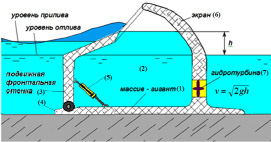World energy is recently more and more focused on new clean technologies based on renewable energy sources. One such source is the energy of the waves. In nature, this energy is presented in the most concentrated form. Wave energy has a higher compared to wind and sun energy density. Sea waves accumulate the energy of the wind over large areas of overclocking. They are, therefore, natural concentrate energy. Nowadays, there exist some types of plants, some of which are successfully used; some of them exist only “on paper”. For example, in December 2005, a review was published under the title «Marine Renewable (Wave and Tidal), Opportunity Review», which deals with many kinds of tidal and wave power. In this review there were two power plants that have attracted my attention: TAPCHAN and Oyster. This review described the advantages and disadvantages of these systems.
Wave converter of TAPCHAN (OWEC) type. On the rising ground of the shore a tank is located above sea level. A tapered channel leads to the tank. The waves come in a wide part of the channel and increase in height as narrowing. Waves are swamped through the channel into the tank. Water returns to the ocean through the pipe. Water flows through the pipe of low pressure turbines of 350 kW. This power station has worked in Norway since 1985, and produces 2 million kW/h of electricity annually. There are some disadvantages:
- the application is limited by the regions where the tides are small;
- severe icing at low temperatures;
- high wave energy losses (due to friction and encounter with a partially reflected waves) during the passage through the channel walls;
- a narrow wavelength range in which the effective concentrator work is able;
- low efficiency when small short waves expose;
- a high level of capital expenditures;
- limitation of the localities where the efficiency of the apparatus is provided.
Wave converter of “Oyster” (OWSC) type. “Oyster” is the wave power station which is located on the sea coast at moderate depths of about 12 meters. Huge plate floats hinged to the base plates located on the bottom are swayed by waves and drive the two-sided piston pump. The pump drives sea water to the shore where it turns the rotor generator. The entire electrical system is placed on the coast.
Disadvantages:
efficient usage only in large waves when there is an intense rocking of flaps;
the ability to shift and destruct installations by storm waves.
The technical result is the creation of a combined structure of the wave converter based on the systems OWSC and OWEC which eliminates their weaknesses and combine their advantages. The objective is to increase the efficiency of the converter of OWEC type by using wave energy in a wide range of height and frequency, reducing losses of wave energy on the front wall and increasing the flow rate in the channels of hydraulic turbines.
The design of the device is shown in the figure 1. Reinforced box caisson (1), forming a tank (2) attached to the bottom. The front wall (3), from the sea, is connected to base plate (4) by means of hinges. The movable front wall and base plate is connected by a linear hydraulic converter (5). In the underwater part of the back fixed wall (6) holes with hydro turbines (7) are located.

Wave converter
The device operates as follows. When wave runs up the front wall takes part of the energy passing it to a linear hydraulic converter (5). Top of wave gushes through the front wall (3) and falls into the reservoir (2) forming water level difference in the sea and in the tank (fluid head). Due to the fluid head current is generated within a hole in the back wall driving the hydro turbine (7). The kinetic energy from work of the linear hydraulic converter and hydro turbine is converted into electrical energy.
The device is used in the energy industry as a power plant. Thus, the wave power plants are certainly a good substitute to the traditional methods of producing energy, but the wave energy is a relatively young industry which still requires a large number of tests, possibly corrections, but rather the mass attention.
Библиографическая ссылка
Гентова А.А., Першина Е.Ю. ПРИМЕНЕНИЕ ВОЛНОВЫХ ПРЕОБРАЗОВАТЕЛЕЙ В ЭНЕРГЕТИЧЕСКОЙ ОТРАСЛИ // Успехи современного естествознания. – 2013. – № 8. – С. 98-99;URL: https://natural-sciences.ru/ru/article/view?id=32729 (дата обращения: 18.04.2024).



